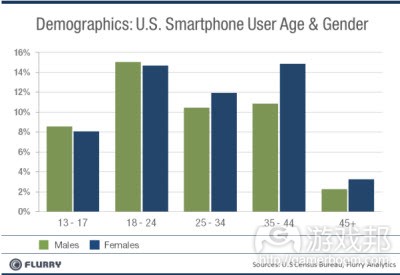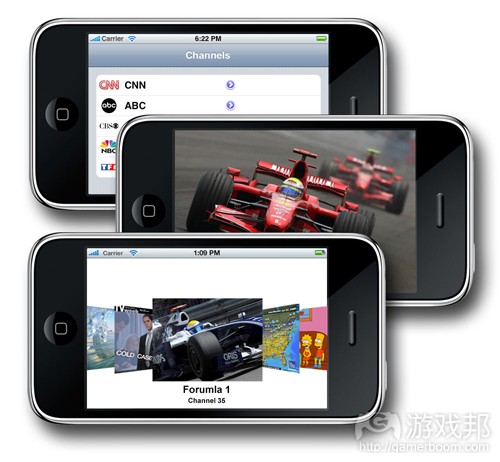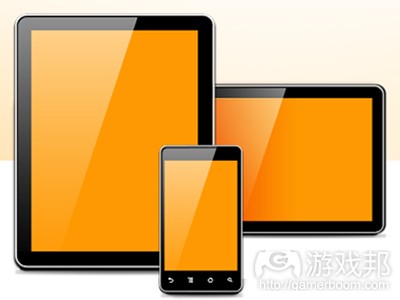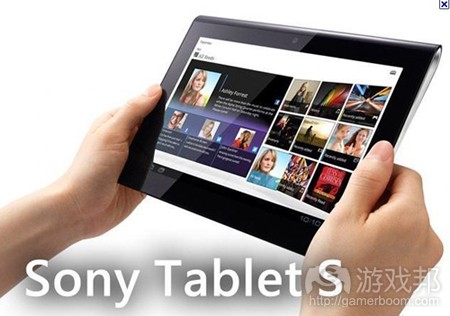每日观察:关注Flurry预测手机应用广告行情(9.1)
1)移动分析公司Flurry最新数据指出,Android和iPhone手机应用中的广告空间正迅速扩张,有可能吸收所有美国在线广告投入(游戏邦注:手机应用市场问世时间仅两年,而美国在线网络市场出现已有15年之久)。
这项调查与市场调研公司Gartner之前的预测较为接近,后者预计2011年全球移动广告营收将达33亿美元,eMarkter则预测2011年全美移动广告投入将达11亿美元。
Flurry追踪了移动广告市场20%的广告展示次数,并发现平均每名用户访问应用时的广告展示次数是4.3,平均广告展示时间是4.2分钟(游戏邦注:网页广告的平均展示时间长度却不足1分钟)。该公司将手机应用的广告空间与美国在线网络广告净投入进行对比,发现手机应用广告每年总投入超过120亿美元,假设其CPM是2.5美元,那么手机应用广告空间价值就可能将从今年1月的3亿美元,上涨至今年12月的10亿美元。
该公司称移动广告市场的快速发展得益于每日超过100万部的手机激活量,除此之外,苹果App Store应用数量已超45万,谷歌Android Market应用数量也超过了25万;用户每日访问手机应用时间比浏览网页时间更频繁,更多发行商在应用中植入广告,广告主更容易接纳在手机应用中投放的广告等因素,也是刺激这一市场发展的重要动力。
Flurry调查还指出,平均每名美国智能手机用户拥有65款应用,他们的平均学历和家庭收入高于美国普通用户的平均值。智能手机应用使用者多集中于年龄群体,女性用户略占优势。
2)法国发行商Gameloft日前发布2011上半年(截止6月30日)财报,该公司合并销售额达7680万欧元(约合1.1亿美元),同比去年增长15%;其营业收入为890万欧元(约合1300万美元),比去年同期的580万欧元增长53%。
如果将基于股票的补偿和其他运营预算考虑入列,Gameloft今年上半年的营业收入应为790万欧元,同比增长68%。
但由于欧元走低,该公司净利润为530万欧元(约合750万美元),基本上与去年同期持平。
从总体上看,Gameloft的最大一项开销是游戏开发R&D环节,其上半年总开销为3700万欧元(约合5350万美元),比去年同期增长16%。
3)硅谷初创企业Striiv最近推出一项售价99美元的移动手持设备,旨在以游戏化机制鼓励用户参与户外活动或培养健康生活习惯。该设备会将用户的每日活动视为一种锻炼身体的机会,对用户爬楼梯、步行等活动进行奖励,同时还鼓励用户通过步行玩游戏,或向慈善机构奉献爱心。
如上图所示的《MyLand》这款梦幻版的《FarmVille》游戏,它支持用户通过移动以获得更多可用于种植庄稼、饲养动物的能量。除此之外,用户还可以参与每日挑战(例如在10名钟内行走2315步,或者攀爬与艾菲尔铁塔同等数量的阶梯,行走与金门大桥同等长度的距离)赢取奖励。
4)中国iOS游戏开发商Haypi(游戏邦注:该公司代表作品《Haypi Kingdom》经常出现在美国营收榜单前列)一名高管在日前的Cocoachina大会上表示,《Haypi Kingdom》这款游戏在美国多个营销渠道投入约15万美元。
与其他休闲模拟游戏不同,《Haypi Kingdom》拥有一部分消费比例高于普通休闲游戏的铁杆玩家,该游戏经常居于美国400至1000名免费游戏之列,但却常在前50名营收榜单露面。
该公司负责人表示,在游戏发布前四个月,由于公司没有对营销活动进行投入,《Haypi Kingdom》排名并不稳定,甚至出现下滑倾向。
该公司从去年10月开始向多个营销渠道进行投入,在Free App A Day花费1.5万美元,向Tapjoy投入5万美元(在苹果限制非自然下载行为之前),向谷歌AdMob广告平台投入5万美元,向苹果iAd投入1万美元。该公司称苹果广告平台作用有限,所以后来取消了在iAd的营销活动。他们还购买了短信应用TextPlus中的广告,发布了一些新闻稿。
该负责人指出,该游戏今年初的每用户获取成本约为20美分,平均每名用户消费额约1.5美元(游戏邦注:虽然这个数据在美国市场看起来比较低,但需注意亚洲市场的用户获取成本更低,ARPU值也较低,而最近几个月iOS限制非自然下载行为后,用户获取成本正不断上升)。Haypi计划在未来数月发布《Haypi Kingdom》的Android版本。
5)市场调研公司In-Stat最近预测,目前已有50%的美国用户通过平板电脑观看电影和电视节目,未来5年移动视频用户将增长3倍左右。
In-Stat调查还显示,50%的18至24岁用户经常通过智能手机和平板电脑向社交网络发布关于视频内容的贴子。该公司还预测未来5年将有86%的用户将通过智能手机和平板电脑观看视频内容,平均每个苹果家庭将拥有4个苹果设备,而每个Android家庭拥有至少2个Android设备。
到2015年,预计有65%的美国人拥有智能手机或平板电脑。由于这两种设备已成长为视频分享和消费平台,内容供应商、设备制造商和运营商应推出具有支持社交互动、屏幕交互、个性化和可移动的多屏使用模式。
6)据Digitimes报道,亚马逊将于10月份发布7英寸平板电脑,2012年第一季度再发布10英寸平板电脑。据称亚马逊7英寸平板电脑将由Quanta制造,售价可能介于200至250美元之间。
7)索尼日前确认索尼平板电脑S将于今年9月发布,起始售价为499美元,支持用户通过该设备下载和体验原来运行于PlayStation的游戏。
26GB的索尼平板电脑S售价499美元,32GB设备售价599美元,采用Android 3.0操作系统,拥有9.4英寸触摸屏、NVIDIA Tegra 2芯片,以及Wi-Fi和3G连网选项。
但该公司并未透露据称将于11月问世,拥有5英寸触摸屏、4G网络的索尼平板电脑P的定价情况。
索尼平板电脑是继Xperia Play智能手机之后,该公司推出的第二和第三款基于PlayStation的移动设备。据Android Market统计资料显示,《Jumping Flash》和《WipEout》等Xperia Play手机游戏下载量并不乐观。(本文为游戏邦/gamerboom.com编译,如需转载请联系:游戏邦)
1)Mobile app ad inventory is growing at staggering rates
Dean Takahashi
Mobile analytics firm Flurry said in a blog post this morning that the ad inventory of mobile apps — all of the space available for ads within apps on iPhone and Android devices — is growing so fast that it will soon be able to absorb all of the online ad spend for U.S. display ads on the web.
That is, the two-year-old market will soon meet the demands of a 15-year-old mature market in online web ads, said Charles Newark-French at Flurry.
The assessment is consistent with projections about mobile ad growth. Gartner estimated that mobile ad revenue would double to $3.3 billion in 2011 on a worldwide basis. eMarketer estimates U.S. mobile ad spending will top $1.1 billion this year.
To calculate these numbers, Flurry tracked the average number of ads shown per session a user has with a mobile app. That number is 4.3, and the session time is 4.2 minutes. The average session length for a web ad is under 1 minute. Flurry tracks about 20 percent of all sessions in the market. Then Flurry compared the inventory available on mobile apps with the net ad spending on display ads in the U.S. online web market. That amount is just over $12 billion per year. Assuming that the CPM (cost per 1,000 impressions) is $2.50, Flurry came up with its numbers shown in the top chart. The figures show that mobile app inventory value will rise from $300 million in January 2011 to $1 billion by December 2011.
The reason the ad market is growing so fast is that over a million devices are being activated daily. The Apple App Store now has more than 400,000 apps and the Android Market has more than 200,000. Users are spending more time in mobile app sessions per day than they do on the web. And more publishers are integrating ads into their apps.
Flurry says the average smartphone user has 65 apps per device. And the average user is better educated and earns a higher household income than that of the U.S. average. Smartphone app users also cluster into younger age groups and trend slightly more female. Overall, Flurry said it has taken a lot less time for advertisers to embrace ads in mobile apps compared to the original display ads for the web.(source:venturebeat)
2)Euro’s strength hits Gameloft as it posts flat H1 2011 profits of €5.3 million
by Jon Jordan
In accordance with French accounting practice, mobile publisher Gameloft (GFT.PA) has announced full details of its financial figures for the first half of 2011, the six months ending 30 June.
As previously released, consolidated sales were €76.8 million (around $110 million), up 15 percent year-on-year.
What’s new is the company’s current operating income, which was €8.9 million, (around $13 million). This was up 53 percent compared to €5.8 million a year ago.
Taking into account stock-based compensation and other operational expenses, operating income was €7.9 million, up 68 percent year-on-year.
Currency converters
However, thanks to losses accrued due to the strength of the Euro against other currencies, notably the dollar, net profit was €5.3 million (around $7.5 million), exactly the same as the half year total in 2010, when Gameloft actually gained €1.3 million of income thanks to currency fluctuations.
Additionally, Gameloft’s largest single expense is game development – listed as R&D – which in H1 2011 was up 16 percent to €37 million (around $53.5 million), compared to H1 2010.
Gameloft ended the six month period with net cash and cash equivalents worth €26.1 million (around $38 million).
Divide and conquer
Dealing with its outlook for the next 12 months, Gameloft said it expects to grow its share of the legacy and shrinking Java and Brew game market as other companies switch to smartphones.
During the first 6 months of 2011, 30 percent of Gameloft’s sales came from smartphones and tablets.
It also expects social networks, smart TVs and next-generation set-top boxes to provide growth opportunities in future.(source:pocketgamer)
3)Striiv to launch portable device make fitness more fun
Dean Takahashi
Games like Wii Fit have made it more fun to stay fit in your living room. But Silicon Valley start-up Striiv wants to motivate you to stay fit outside the living room, when you’re walking around at work or running errands. It will do so with a $99 portable device that measures your movements and gives you rewards based on your activity level.
David Wang, chief executive of Redwood City, Calif.-based Striiv, said in an interview that the Striiv portable fitness device lets you turn everyday activities into fitness opportunities.
The gadget measures your every step, even when you’re walking up stairs, and gives you chances to hit personal goals, play games with friends, and make donations via walkathons.
“We want to build a movement around movement,” Wang said. “We see it as the intersection of social gaming, digital health and next generation of philanthropy.”
The device is part of a larger movement to “gamify” health and fitness, or making non-game activities more game-like through rewards and game design. Lexi Franklin, head of strategy and design, believes that this is way to reach the larger mass market of people who don’t exercise as regularly as they should. These people know that they should exercise more but can’t bring themselves to do it.
“There’s a gap between knowing and doing that we can address,” Franklin said. “Instead of negative reinforcement that makes you feel bad about what you haven’t done. We give you positive reinforcement for all of the small things you do to improve your fitness, like walking to lunch or taking the stairs. You get rewarded for every activity you do in a day.”
Added Wang, “There are the Type A people who are self-motivated. We wanted to do something for the people who aren’t like that. We believe the current definition of fitness is leaving out so many people. This has the potential to transform your identity, or how you feel about yourself.”
In the first game, MyLand (pictured in the top image), your enchanted island fills with more exotic wildlife and plants the more you move. It’s kind of like a fantasy version of FarmVille, with centaurs and crops. You can grow things by using energy, and you can get more energy by moving around. No setup is required and the device has its own tutorial.
You can also undertake daily challenges, such as bonuses for taking a lot of steps in a short time, like taking 2,315 steps in ten minutes. The device prompts you to walk as many stairs as are in the Eiffel Tower, or you can walk a distance equal to the length of the Golden Gate Bridge.(source:venturebeat)
4)How Haypi Kingdom Got And Maintained Its Top Grossing Rank
By Kim-Mai Cutler
Haypi, the Chinese developer behind of iOS’ consistently top grossing games in the U.S., shared pieces of the marketing recipe that helped break its title Haypi Kingdom into the top of the charts. The company spent slightly north of $150,000 across a number of channels, chief executive Haozhi Chen said at an iOS developer conference from Cocoachina over the weekend in Beijing.
Unlike many of the casual simulation games that usually appear at the top of the grossing charts, the company’s game Haypi Kingdom follows more of the midcore model. It has a smaller number of players who monetize at a higher rate than many of its peers do. It’s usually between 400 and 1000 on the free charts in the U.S., but almost always in the top 50 on the grossing list. Think of it like the Kabam-model of gaming, except on iOS.
In the first four months after launch, Chen said the game saw instability in its ranking and the classic spike up the charts and then decline because the company didn’t invest in marketing.
But then Haypi started spending across a number of channels in October of last year. It spent $15,000 on Free App A Day, the popular service that gives away and heavily promotes apps for a single day. He advised developers to plan ahead if they want to use the service, as it’s often booked out for months. “Free App A Day will not follow your schedule,” he said.
He also spent about $50,000 on Tapjoy, before Apple cracked down on the company’s model where it drove installs through offer walls in a network of games. Haypi also put $50,000 into Google’s AdMob advertising network and $10,000 into iAd. But Apple’s ad network didn’t perform as well, so they pulled the campaign. They also bought ads in the messaging app TextPlus and did some press releases.
“PR is like a buying a luxury,” Chen added, saying it was not really necessary.
Chen said his cost to acquire a user at the beginning of the year was about 20 cents and that the average user’s “contribution,” which appears to be the same as lifetime value although the translation was not perfectly clear, was $1.50. (If these numbers sound lower for a U.S. audience, just keep in mind that acquiring users in Asia is often cheaper, ARPU is lower in the region, and that user acquisition costs have risen in recent months with the loss of incentivized installs.)
“Our input-output ratio is really good,” he said. Haypi plans an Android version of the game in the next several months.(source:insidemobileapps)
5)Half of US tablet owners watch films and TV shows on their devices
by Stuart Dredge
In-Stat research also predicts that frequent mobile video users will triple over the next five years.
50% of US tablet owners watch films and TV shows on their devices, according to the latest report from In-Stat.
Its survey also highlights the ongoing trend of ‘second-screen’ behaviour in the living room. According to In-Stat, nearly 50% of 18-24 year-old smartphone and tablet owners regularly post on social networks about the TV shows they are watching.
It also predicts that frequent mobile video users will triple in the next five years; that 86% of smartphone and tablet users will watch video on their devices; and that the average Apple household will have four Apple devices, while the average Android household will have at least two Android devices.
“Tablets, in particular, have become a primary video device, both inside and outside the home,” says research director Keith Nissen.
“By 2015, our research projects that 65% of the US population will own a smartphone and/or tablet. As these devices become a center-point for video engagement and consumption, content providers, device manufacturers, and operators need to support a multiscreen usage model that reflects social interaction, screen interaction, personalisation, and mobility.”(source:mobile-ent)
6)Amazon’s 7-inch tablet on track for October, 10-inch coming early 2012
Devindra Hardawar
Amazon is expected to ship a powerful 10-inch tablet in the first quarter of 2012, while its 7-inch tablet will make its way to consumers in October, according to Digitimes.
That timing isn’t exactly surprising: Amazon needs a cheap tablet out by this holiday season to compete with the Nook Color and iPad, and it’s larger variant likely needs more development time to make it competitive against next year’s iPad 3.
In May, the mobile site Boy Genius Report claimed that Amazon was developing a dual-core 7-inch tablet codenamed “Coyote”, and a powerful 10-inch quad-core tablet called “Hollywood.” Both tablets will run Android, but I wouldn’t be surprised to see some major design customizations from Amazon.
Sources tell Digitimes that Foxconn will begin manufacturing Amazon’s 10-inch tablet come the first quarter 2012. Foxconn also builds Amazon’s Kindle e-reader, which is also expected to get refreshed in the coming months. Amazon’s 7-inch tablet is said to be built by Quanta.
Amazon CEO Jeff Bezos practically confirmed that the company was developing tablets back in May. A new Amazon site design revealed yesterday also points to the company delivering tablets soon.
The company is expected to offer heavy integration with its media services in the tablets, and also offer the 7-inch model at an attractive price, likely between $200 and $250. Amazon is perhaps the best-positioned company to take on the iPad, since it’s an e-commerce giant with its own digital media offerings. The company could easily sell its tablet hardware at a slight loss — like Barnes and Noble did with the $250 Nook Color — with the hopes of making some of that back via media purchases.(source:venturebeat)
7)Sony Reveals More Details On First PlayStation-Certified Tablets
by Kyle Orland
Sony has confirmed the price and release details for its Sony Tablet S, which will hit stores in September starting at $499 as the first tablet able to legally download and play select games from the original PlayStation library.
First revealed back in April, the Android-3.0-powered tablet sports a 9.4-inch touch display and an NVIDIA Tegra 2 graphics chip, as well as Wi-Fi and 3G connectivity options. The $499 model comes with 16 GB of built-in memory, while a $599 model comes packed with 32 GB.
Sony didn’t provide pricing details for the previously-revealed Sony Tablet P, a foldable tablet with two 5.5-inch touchscreens and 4G network capability set for a November release. Each screen can be controlled independently by Android apps, with one screen providing a PlayStation-style controller interface and the other showing gameplay, for example.
The tablets will be Sony’s second and third PlayStation-certified mobile devices, after the Spring launch of Sony Ericsson’s button-sporting Xperia Play smartphone.
Available downloadable PlayStation titles, including Jumping Flash and WipEout, have failed to attract a significant number of downloads on that device, according to publicly available Android Marketplace statistics.
Both tablets are available for immediate pre-order ahead of their launches.(source:gamasutra)

















































 闽公网安备35020302001549号
闽公网安备35020302001549号